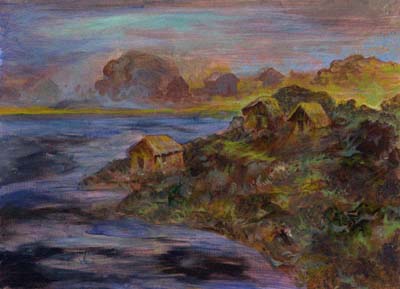Slavs on the eve of Hungarian invasion
(9th-10th century)
In the entire area explored so far only two structures from the 9th-10th century were found. Both structures are houses shallowly dug-in slide 119, 120, 121, 122 with technical drawing and animation of a rectangular base, with a clay fireplace in the central area. Only one of them has been excavated in full, while the other was damaged by digging in the 17th century as well as by the brick works. Of pottery in the houses and fireplaces only pots were found, made on a slow wheel photo 176 and decorated by etched-in horizontal and wavy lines along the entire body, apart from two pieces made by kneading photo 177. Pottery made on a slow wheel, decorated in the same manner as the pots from Čurug, was found in the vicinity of Zemun, in a settlement from the second half of the 9th century and the beginning of the 10th century, as well as in the vicinity of Vršac and in settlements and graves in Hungary, where it was dated to the 9th and 10th century. In the Bačka region similar ceramics on a slow wheel was found in Botra near Bečej, from the 8th-9th century, and in the “Veliki Put” site near Čantavir, from the 9th century, but kneaded pottery is present in a far larger percentage in these sites. Considering the said analogies, as well as the small percentage of kneaded pots, the houses from Čurug might be dated to the end of the 9th and beginning of the 10th century. The characteristics of the pottery from this structure undoubtedly point towards a Slavic population from the time of Hungarian conquests map 6. [1]
Of other objects parts of two tools for combing wool were found in one of the houses photo 178, as well as a part of a steel spade, photo 179, a bone mouthpiece photo 180 for some kind of bellows, a bone awl photo 181 and a clay weight photo 182.
The house that was entirely excavated was damaged by a slightly younger dig in the form of a storage pit in which a store of bronze objects was located photo 183, among which there was one bronze belt pin photo 184, as well as two spinning-wheel disks and a bone awl photo 185. The objects were probably stored in a cloth or leather bag, tied with a leather belt. The dating of the storage itself might be determined as the time of the Hungarian conquests of these parts.
[1] Taken from the catalogue of the exhibition by M. And Đ. Janković, Slavs in the Yugoslav region around the Danube, Belgrade 1990.

